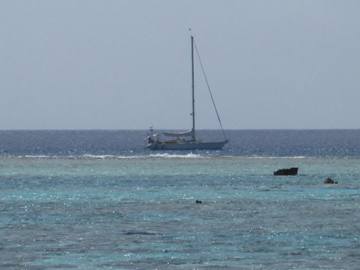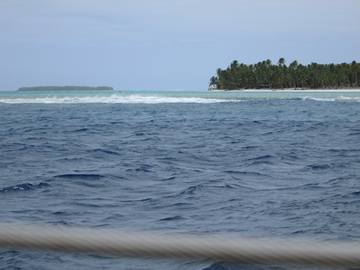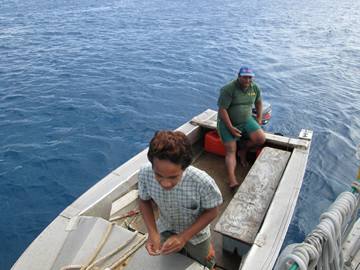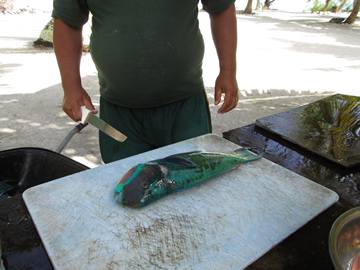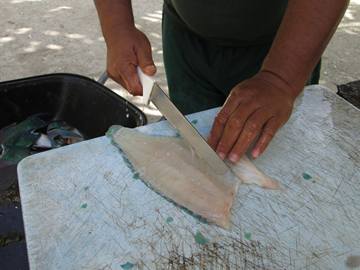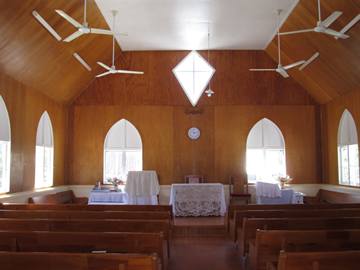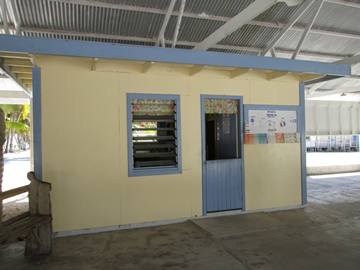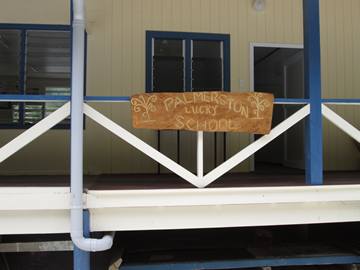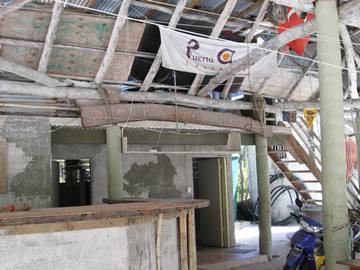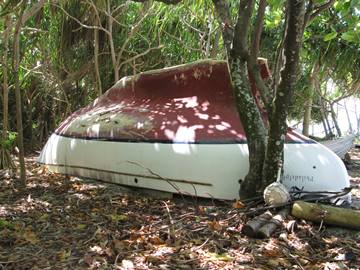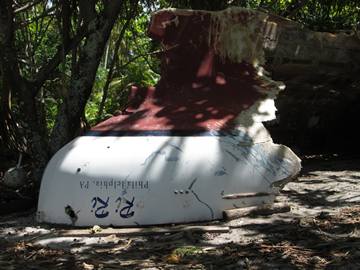Sunday 9th September - Palmerston - Now for Something a Little Different

19:03.26S 169:55.51W Sunday 9th September – Palmerston - Now for Something a Little Different We managed to establish radio contact with Bob Marsters early on Tuesday morning and at around 1100 he drove his aluminium dinghy powered by a 15HP outboard engine out from the beach of Palmerston Island, through the reef using ‘Little Passage’ to lie alongside Arnamentia, bringing with him the officials we needed to satisfy before being allowed entry. There was quite a stiff breeze and life at the mooring was fairly bouncy. It was more or less OK on board but transferring to and from Arnamentia to the dinghy required quite a bit of agility. The male nurse based on the island – whose job it was to pass judgement on our state of health and infestation/hygiene – was nimble enough to make it but the chap whose job it was to complete the entry forms etc felt he’d be better placed remaining aboard the dinghy. Our first concern was that to do so he had our passports and ship’s papers rattling around in this tiny vessel in a seaway for rather longer than we’d have wished. More ominously, five minutes later there was a shout of “Whale!” from Bob and there were a few anxious minutes as a humpback approached the dinghy- we had visions of an upturned boat with its crew (sans buoyancy aids) and our papers bobbing up and down in the oggin. But this whale knew what it was doing and proceeded to do a party piece circuit of the moorings - at one point coming within almost touching distance of Arnamentia’s cockpit. Eat your heart out, James Raley! As ever, the camera was in a drawer at the crucial moment!
Arnamentia moored – a view from the lagoon The reef – a view from Arnamentia Given the conditions, we decided to stay aboard on Tuesday. We had some important maintenance tasks to do in any case. The 660NM passage from Bora Bora had been pretty bouncy and we’d taken a lot of water over the bow. All that’s fine but we hadn’t done what we should have done in disconnecting the bower anchor from its chain, sending the chain ‘home’ to the chain locker and properly sealing off the anchor locker from the deck. It’s not something you want to be bothered with once in ‘anchoring territory’ but setting off without doing so, on a passage of more than 600NM in weather that was likely to produce confused seas and big swells, wasn’t clever. So, we ended up with a lot of water in the bilges throughout the passage. Not only did this require a great deal of pumping out (hurrah for electric bilge pumps!) but that amount of water sloshing around in anchor lockers, chain lockers and bilges is likely to result in otherwise avoidable repair jobs. So it turned out. Although it was not critical in Palmerston, the windlass wasn’t working again by the time we arrived. Having pretty much bomb-proofed the anchor locker electrical connections in Moorea, Jon was fairly confident that the problem wasn’t to be found there. It wasn’t; it was a corroded and broken connection in the chain locker, where the windlass motor is mounted. That’s a bit of a pig of a space to access. And, the connectors here are necessarily big because they carry large currents to drive the electric motor on the windlass. We’d no spare suitable connectors aboard so one had to be cobbled together by cannibalizing other electrical assemblies and drilling and bolting bits together. The result is not elegant but is ruggedly utilitarian, smothered in grease and, fortunately, out of sight. And, it’ll pass muster until we get to NZ. There were a couple of other electrical niggles which had arisen – or perhaps been brought to a head - as a result of too much sea water washing the inside of the hull walls. So, we sorted those out (mainly replacement connectors but also one step-down transformer). Electrical niggles sorted, we did what we should have done in the first place and prepared the anchor, anchor locker, chain and chain locker for more big seas once we left Palmerston. Wednesday saw calmer conditions so at around 10 o’clock Bob came back to collect us and a Dutch couple, Etienne and Denise, from La Luna. Not only are yachts forbidden from attempting to enter the lagoon – so are yacht tenders and with good reason. The aptly named “Small Passage” was twisty, bouncy and for an appreciable stretch shallow enough to require very cautious use of the outboard engine by someone who really knew what he was doing and where he was going, in a dinghy that could take a bit of punishment on the coral if he got it fractionally wrong. No place for a rub-a-dub here. But Bob is used to this. When supply ships arrive – every 3 or 4 months – they anchor outside the reef and the islanders work day and night ferrying incoming supplies ashore through the reef and the parrot fish, they are exporting, out. Mind boggling. Once ashore it was only a few yards to Bob’s home, where his daughter welcomed us with cold lime squash and freshly made doughnuts – very yummy! Bob and Andrew Marsters – our taxi arrives Most of the islanders’ income is made from netting parrot fish and filleting and freezing them ready to be shipped off to the main Cook Island, Rarotonga. No copra here – it isn’t subsidized here as it is in French Polynesia and without that support it’s not an economic proposition for Palmerston. Bob showed us that he is not only an expert reef pilot but also a nifty hand with the filleting knife. In less than a minute two beautiful, boneless parrot fish fillets were ready for cling filming. Then it was Jon’s turn; not surprisingly his efforts will not be gracing any plate in any Rarotonga 5* hotel.
Parrot fish – who’s a pretty boy, then? Expertly filleted – more to come from the barrow Bob’s son, Andrew, took us for a walk around part of the island showing us the newly re-furbished church; clearly Protestant with its clean simple lines both inside and out.
We also spotted the nurse/health inspector Simeon in his surgery- it must be rather a dull life on an island where the diet is pretty healthy - well apart from those doughnuts!
The Surgery Nowhere near the surgery - caption gratuitous In contrast, Rose -a young teacher who hails from Bridport in Dorset and is on a 3 year contract - is kept very busy teaching all age groups and subjects, mainly from standard text/question books supplied by New Zealand but also backed up with resources from the internet.
The happiest days of your life? I should say so! The island has a diesel generator that runs for about 12 hours every day (each family has smaller ones to service its own continuous needs), satellite connections provide the island with TV and internet and a fair proportion of the 25 or so adults are employed in one way or another in the administration of the island. Bob is the mayor, there is a treasurer, others cover customs and immigration and so on. Otherwise the three family groups are remarkably self-contained. Each family group owns a portion of the island; lives there and has its being. The family owns property – individuals do not. There are three cemeteries – one in each portion of this tiny place - and you don’t get to choose which one you are destined for. If two people from different families marry, the bride moves, loses all rights in her parent family’s property and acquires new ones in her husband’s. Bob remarked that since about the 1960’s there has been a more general tendency for islanders to marry outsiders rather than their aunts (his words). Given that most islanders look distinctly more Polynesian than European, that healthy broadening of the gene pool appears to have been going on for longer than that. This self-containment within families is astonishing. There is no shop because every family orders from its relations in Rarotonga what it needs to be delivered every few months by supply ship. It catches its own parrot fish, keeps its own (very free range) chickens and a pig or two and harvests its own coconuts. Eggs are rarely eaten because, in Bob’s words, you can’t feed a family on an egg – you can on a chicken. The pace of life is distinctly Polynesian. On our walk, we saw a number of projects in various stages of completion (including a yacht club – “Go figure” as the Americans might say). Progress is stately. The Yacht Club – a work in (slow) progress Jon popped into the Admin office to get our clearing out paperwork sorted and the rest of us chatted to a few chaps who were trying to mend a generator – well, they were at the ”having a good look at it first” stage but seemed happy enough to break off and pass the time of day. It appears that most of the islanders of the have spent quite some considerable time away from Palmerston, mainly in New Zealand, either working or studying. At the end of our walk, another treat was in store – a delicious lunch of parrot fish with garlic sauce and butter – and more doughnuts! As we left to come back to Arnamentia we were presented with several of the day’s frozen fillets and what was left over from lunch. In return, we gave the family some rice and pasta, a few tins of veggies, a T shirt and some notebooks and pencils. However, what Bob was really after was a few small fishing hooks for night time red snapper fishing. Our hooks are quite a lot larger than he was after but we gave him some anyway. Others coming this way please note. Money is of little use really. Size 6/0 deep sea fishing hooks are too big - a few smaller ones suitable for jigging on the reef are the answer. The dangers of sailing in these waters were brought home to us when we walked along the beach to go snorkelling within the lagoon. The landmark indicating the best spot is now marked by the wreck of Ri Ri (40’ or so of full length keel double-ended yacht) amongst the trees just behind the beach. She was wrecked on the reef a year or so ago having chafed through her mooring rope in bad weather. Her crew were saved and the islanders helped salvage most of the kit from on board. They then removed the lead from the keel and towed the hull ashore. She is a very sorry sight and must once have been a very capable offshore yacht.
A sorry end for a fine looking vessel Palmerston was a very different experience. We certainly couldn’t have been made more welcome - indeed we were told that for the time we were on the island we were honorary members of Bob’s family – indeed an honour. Whichever family adopts you it will be much the same story. They see it as their duty to feed and host you. They ask for nothing in return but welcome whatever you can let them have to help them live. Our next port of call was to be the small island state of Niue and we had planned to leave at around lunch time on Wednesday. However, the morning brought strong northerly winds, making life uncomfortable at the mooring and so we slipped shortly after breakfast for the 400 mile passage. We knew that we had another trough to pass through en-route and that, therefore, we’d be in for a bit more poles up, poles down, reefs in, reefs out for at least 24 hours in the middle of the passage. As we passed through the centre of the trough we naturally encountered very light winds for a time before they switched from due north to due south and then backed round to the east. That delay meant that our approach to Alofi bay, Niue would be at night. We decided to give this a go as the excellent pilot gave the latitude and longitude of each row of mooring buoys and we understood that there would be red leading lights and fluorescent strips on the buoys. There were no red transit lights but the wharf where they should have been was brightly lit and we did have a transit bearing. The fluorescent strips were in evidence – thank you Niue Yacht Club - and shortly after midnight on Sunday morning we tied up to buoy no 13 after three days and two and a half nights at sea. |
